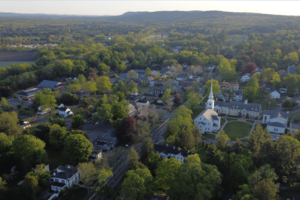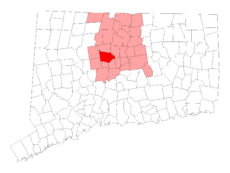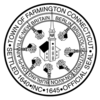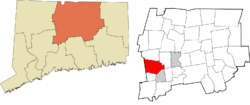Farmington, Connecticut facts for kids
Quick facts for kids
Farmington, Connecticut
|
||
|---|---|---|

Aerial view of the Farmington Historic District
|
||
|
||
| Motto(s):
"Respecting History, Planning The Future"
|
||
 Hartford County and Connecticut Hartford County and Connecticut |
||
| Country | ||
| U.S. state | ||
| County | Hartford | |
| Region | Capitol Region | |
| Settled | June 1640 | |
| Incorporated | December 1645 | |
| Consolidated | 1947 | |
| Communities | Farmington Bensted Corner East Farmington Heights Farmington Station Oakland Gardens River Glen Unionville |
|
| Government | ||
| • Type | Council-manager | |
| Area | ||
| • Total | 28.8 sq mi (74.5 km2) | |
| • Land | 28.0 sq mi (72.6 km2) | |
| • Water | 0.8 sq mi (2.0 km2) | |
| Elevation | 161 ft (49 m) | |
| Population
(2020)
|
||
| • Total | 26,712 | |
| • Density | 928.6/sq mi (358.55/km2) | |
| Time zone | UTC−5 (Eastern) | |
| • Summer (DST) | UTC−4 (Eastern) | |
| ZIP Codes |
06032, 06085
|
|
| Area code(s) | 860/959 | |
| FIPS code | 09-27600 | |
| GNIS feature ID | 0213430 | |
| Interstates | ||
| U.S. Highways | ||
| State Routes | ||
Farmington is a town in Hartford County, Connecticut. It is located in the central part of the state. The town is part of the Capitol Planning Region. In 2020, about 26,712 people lived there.
Farmington is about 10 miles west of Hartford. It is also close to major highways like I-84. Bradley International Airport is 20 miles north. You can drive to New York City or Boston in about two hours. Many big companies have had their main offices here. These include Otis Elevator Company and United Technologies. Unionville is a suburban area in the northwestern part of Farmington.
Contents
History of Farmington
Early Settlement and Growth
The Tunxis Native American tribe first lived in the Farmington area. In 1640, English settlers from Hartford started a community here. This made Farmington the oldest inland settlement west of the Connecticut River. It was the twelfth oldest community in the entire state. The settlers liked the area because of its rich soil. It was also located along the Farmington River.
The town and river got their names in 1645. This year is considered when the town officially became a town. Farmington's borders grew many times. It became the largest town in the Connecticut Colony. It was named "Farmington" because it was a great place for farming.
Farmington is often called the "mother of towns." This is because its huge area was later split up. Nine other towns in central Connecticut were formed from parts of Farmington. Unionville, a part of Farmington, used to have many factories. These factories used the water power from the Farmington River.
Revolutionary War and Freedom Seekers
Farmington has a rich New England history. Main Street has many old colonial homes. Some of these homes were built in the 1600s. In 1774, the people of Farmington protested against a British law. They held a mock trial for the law and then burned a copy of it.
During the American Revolutionary War, George Washington visited Farmington often. He called it "the village of pretty houses." French troops, led by General Rochambeau, also stayed in Farmington. They were on their way to help Washington's army.
Many Farmington residents were against slavery. They helped enslaved people escape to freedom. Several homes in town were "safe houses" on the Underground Railroad. Farmington became known as "Grand Central Station" for those seeking freedom.
Farmington also played a role in the famous Amistad trial. In 1841, 38 Mende Africans were housed in Farmington. They were leaders of a revolt on a slave ship called the Amistad. The U.S. government did not help them return to Africa. So, Farmington residents raised money for them. They also taught the Mende people English and Christianity.
Farmington Canal and Trails
The Farmington Canal was built to connect New Haven with Northampton, Massachusetts. It ran through Farmington from 1828 to 1848. Later, a railroad used the same path. Parts of this railroad were active until the 1990s. Today, parts of the canal and railroad line are walking and biking trails. These are called the Farmington Canal Heritage Trail and the Farmington River Trail.
Geography and Nature
Farmington covers about 74.5 square kilometers (28.8 square miles). Most of this area is land, with a small amount of water.
Farmington used to be much larger. Over time, parts of it became other towns. These include Southington, Bristol, Avon, and Plainville. Today, Farmington borders towns like Avon, Burlington, and West Hartford. It also borders the cities of New Britain and Bristol.
The town is mostly covered by woods. But it also has meadows and hills, especially in the east. There are many ponds and lakes too. The Farmington River flows through the town. It enters Unionville and then turns north towards Avon. The Metacomet Ridge is a long line of low mountains. It runs along the east side of Farmington. These mountains include Pinnacle Rock, Rattlesnake Mountain, and Talcott Mountain.
Population and People
| Historical population | ||
|---|---|---|
| Year | Pop. | ±% |
| 1756 | 3,707 | — |
| 1774 | 6,069 | +63.7% |
| 1782 | 5,542 | −8.7% |
| 1790 | 2,696 | −51.4% |
| 1800 | 2,809 | +4.2% |
| 1810 | 2,748 | −2.2% |
| 1820 | 3,042 | +10.7% |
| 1830 | 1,901 | −37.5% |
| 1840 | 2,041 | +7.4% |
| 1850 | 2,630 | +28.9% |
| 1860 | 3,144 | +19.5% |
| 1870 | 2,616 | −16.8% |
| 1880 | 3,017 | +15.3% |
| 1890 | 3,179 | +5.4% |
| 1900 | 3,331 | +4.8% |
| 1910 | 3,478 | +4.4% |
| 1920 | 3,844 | +10.5% |
| 1930 | 4,548 | +18.3% |
| 1940 | 5,313 | +16.8% |
| 1950 | 7,026 | +32.2% |
| 1960 | 10,813 | +53.9% |
| 1970 | 14,390 | +33.1% |
| 1980 | 16,407 | +14.0% |
| 1990 | 20,608 | +25.6% |
| 2000 | 23,641 | +14.7% |
| 2010 | 25,340 | +7.2% |
| 2020 | 26,712 | +5.4% |
| Source: Interactive Connecticut State Register & Manual and U.S. Census Bureau, Population Division | ||
In 2010, Farmington had about 25,340 people living there. Most residents were White (85.92%). There was also a significant Asian population (9.59%). About 2.98% of people were Hispanic or Latino.
Economy and Jobs
Farmington has many important employers. Here are some of the top ones:
| # | Employer | # of Employees |
|---|---|---|
| 1 | UConn Health | 7,664 |
| 2 | Otis Worldwide | 4,077 |
| 3 | Companions & Homemakers | 3,000 |
| 4 | Trumpf | 1,700 |
| 5 | Town of Farmington/Board of Education | 830 |
| 6 | ConnectiCare | 750 |
| 7 | Tunxis Community College | 500 |
| 8 | American Red Cross | 428 |
| 9 | Connecticut Spring and Stamp | 375 |
| 10 | Jackson Laboratory | 370 |
United Technologies used to have its headquarters in Farmington. Otis Worldwide is also based here. Other major companies with offices in Farmington include Carvel, ConnectiCare, and Horizon Technology Finance. The American Red Cross and Stanley Black & Decker also have a presence.
The Jackson Laboratory is building a new facility in Farmington. It is located at the University of Connecticut Health Center. This lab focuses on genomic medicine research. This project is part of BioScience Connecticut. It aims to make Connecticut a leader in biomedical research.
Farmington is special because more people work in the town than actually live there. This is not typical for most suburbs.
Arts and Culture
Historic Places to Visit
Farmington has many places listed on the National Register of Historic Places. These include old homes and buildings.
- Farmington Historic District is a large area with many historic buildings.
- First Church of Christ is a beautiful old church.
- Hill-Stead Museum was completed in 1901. It was designed by Theodate Pope Riddle, one of the first female American architects. The museum has 19 rooms filled with famous Impressionist paintings. These include works by Claude Monet and Edgar Degas. It is also a National Historic Landmark. The museum hosts an annual poetry festival.
- Stanley-Whitman House is another very old house, added to the register in 1966.
Education
Farmington has excellent public schools. They are known for being among the best in Connecticut. The town has four elementary schools for younger students. These are Union School, West District School, Noah Wallace School, and East Farms School. West Woods Upper Elementary School is for grades 5 and 6. Irving A. Robbins Middle School serves grades 7 and 8. Farmington High School is for grades 9–12.
Miss Porter's School is a private school for girls. It helps students get ready for college. The school is in Farmington's Historic District. It was founded in 1843 by Sarah Porter. Many famous women have attended Miss Porter's School. These include Jacqueline Kennedy Onassis and Lilly Pulitzer.
Tunxis Community College is also located in Farmington.
Infrastructure and Services
The University of Connecticut Health Center is a major part of Farmington. It employs thousands of people. The Health Center includes John Dempsey Hospital. This hospital has the only full-service emergency room in the Farmington Valley. It also has a special unit for newborn babies.
Connecticut's first temple of the Church of Jesus Christ of Latter-day Saints opened in Farmington in 2016.
Transportation
Local bus service is provided by Connecticut Transit Hartford.
Notable People
Many interesting people have lived in Farmington. Here are a few:
- Tim Abromaitis – a professional basketball player.
- Nick Bonino – an NHL hockey player.
- Ron Francis – a former NHL hockey player.
- Michael Gladis – an actor who grew up in Farmington.
- Curtis Jackson – also known as the hip hop rapper 50 Cent.
- Tebucky Jones – a former New England Patriots football player.
- Erin Pac – an Olympic bobsledder who won a bronze medal.
- Alfred Atmore Pope – an industrialist and art collector.
- Theodate Pope Riddle – a famous architect who founded the Hill–Stead Museum.
- Kathleen Rubins – a NASA astronaut.
- Pawel Szajda – an actor who was born and raised in Farmington.
- Kristen Taekman – a model and TV personality.
- Mike Tyson – a famous boxer who used to live here.
- Suzy Whaley – the first female golfer to play in a PGA event.
- Wilford Woodruff – the fourth president of the Church of Jesus Christ of Latter-day Saints.
Images for kids
-
Northwest View of Farmington from Round Hill, by John Warner Barber, 1836
See also
 In Spanish: Farmington (Connecticut) para niños
In Spanish: Farmington (Connecticut) para niños







